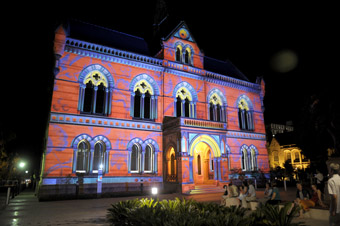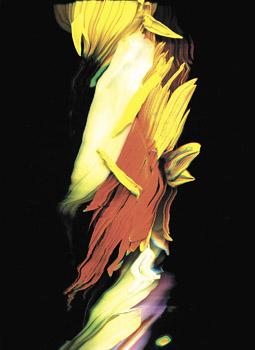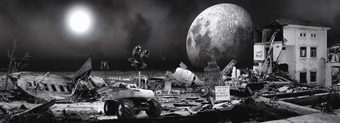in the shadow zone
visual arts in the 2008 adelaide festival

Northern Lights, Adelaide Festival
A STRONG CHILHOOD MEMORY FROM THE 1950'S IS OF ADELAIDE'S FLOWER DAY, AN ANNUAL DAY AND NIGHT FREE EVENT WHEN NORTH TERRACE AND KING WILLIAM STREET WOULD BE AWASH WITH VIVID DISPLAYS BY FLORISTS, GROWERS AND ASSORTED ORGANISATIONS. THE SENSE OF BOUNTY, OF GENEROSITY AND THE POWER OF FLORAL COLOUR AND SCENT WAS ALMOST OVERWHELMING. THE LIGHTING OF THE BUILDINGS ON NORTH TERRACE THIS YEAR BY THE SYDNEY-BASED ELECTRIC CANVAS YIELDED A SIMILAR SENSE OF OCCASION. FROM THE OLD STATE LIBRARY TO BONYTHON HALL, RICHLY COLOURED, PROJECTED OVERLAYS HEIGHTENED AND PARODIED ARCHITECTURAL STYLES.
Each night, large crowds, many children among them, wandered the precinct, quietly enjoying the transformations as each building morphed through some four states every five minutes. The audience itself was fascinating: everyone seemed to be weilding cameras—the latest tiny digitals or long-lensed monsters on tripods or mobile phones of every vintage—and all doing the photographer dance.

Huang Po-Chih, Flov”er, 2006 (video still), courtesy the artist
In the Anne & Gordon Samstag Museum of Art's show of Contemporary Art from Taiwan, Penumbra (referring to the faint shadow accompanying the eclipse of the moon), Photoshopped flowers danced in wondrous animations, petals and stems twirling and twisting into brilliant, ephemeral sculptings (Huang Po-Chih, Flov”er, 2006, the title an aptly sensual conflation of flower and lover). In Tseng Yu-Chin's Acid Tongue (2007), a four-screen video installation, large images almost reduced to black and white move in slow motion. Each scene evokes communality—a meal, a karaoke party, a car trip to the country, a classroom lesson—but instead of pleasure, which is certainly evident, the mood and tonality are dark, ominous even as faces in moments of awe, commitment or release are stilled and additional light added, the surrounding setting momentarily dropping out. The sense of a memento mori is potent, heightened by the still-but-moving dynamic of this beautiful, demanding work (the opaque title apparently refers to events in the artist's life).
Wang Ya-Hui's video, comprising five works, seamlessly follows a tiny cloud as it descends from the heavens, enters a humble home (once part of the artist's early life), drifts through rooms, past a mirror, up over the stairs and out into a hazy sky. We marvel at this simple magic, the fragility, transparency and the constant vaprous re-shaping of the cloud, and enjoy the pleasure of our inquisitive little visit. Wu Diing Wuu is an indigenous Taiwanese artist. His series of lenticular prints of images of indigenous Atayal people (2007), drawn from anthropological and Imperial Japanese photographic collections, transform as you pass by them—dropping out, for example, a traditional woman weaver but leaving behind her loom and a pair of younger women. People become ghosts and then disappear altogether. The sense of culture lost is palpable, resonating subtly with the more recent domestic imagery of Tseng Yu-Chin's Acid Tongue.

Kuo I-Chen, 41° N, 74° W, from the Survivor project, 2007, courtesy the artist and Galerie Grand Siecle, Taipei, Taiwan
Kuo I-Chin's large scale installation, Lose Contact (2005), is also about a sense of loss—for the sole survivor of an apocalyptic event. The room is dominated by a huge digital print of a ruined, denuded, rubbly Earth over which a massive moon unnaturally hovers. A smaller print shows the moon over a Mars robot. At the room's centre a version of the actual robot swivels its eye as you draw near. Distant radio talk in various languages crackles, crickets click, jungle noises buzz and caw. Close by, a projector and a small globe of the Earth rolling on a horizontal axis throw up images of moonwalkers, newspaper headlines, soldiers and space ships circling the planet, evoking a pre-apocalyptic celebration of exploration. On the floor a large projection of an aerial view of urban Earth—buildings, streets and highways—stutters in and out of view (filmed, apparently, from a camera attached to a balloon-held toy aeroplane). On the large digital print, amidst the overhanging moonscape, a shipwreck and blasted buildings (collaged from Google-sourced images) are handwritten signs: “I'm still here.” “Help! Help!” “Katrina was big. But God is bigger.” Lose Contact conjures a curious mix of boyish sci-fi fascination and very real fear, the intense black and white of its imagery suggesting a documentary of an Earth already lost.
Penumbra's curator Sophie McIntyre tells us about the younger generation of Taiwanese artists represented here. The liberalisation of Taiwan in the 1990s has allowed them to move beyond identity politics to develop a more global outlook, realised through working almost totally with new media. Nonetheless, McIntyre detects a certain melancholy about the rapid cultural and technological transition, a slight sense of disorientation. For her, the word 'penumbra' captures that sense of transition, of a grey area, of a country that is not yet recognised as a country. McIntrye speaks of the “ambiguous poetry” of Flov”er, an apt description for this utterly engaging exhibition as a whole with its ambiguous play of light and dark, of past, present and future.
At the Experimental Art Foundation, German artist Mischa Kuball's Re:Mix/Broca II (Letter/Numbers) [2007] generates more abstract but no less beautiful images. Six Kodak projectors, close to the floor, each rotate, sending out letters and numbers clockwise and anti-clockwise that glide across walls near and far, never going out of focus while changing radically in scale in a mesmeric dance of meetings and near misses. Ten small, burnished metal sculptures, like curled little mountain peaks, momentarily interrupt the projection streams, sparking and bouncing the light around us. The letters and numbers sneak into a neighbouring room where an amorphous projection onto a foil screen generates slow waves and clouds of immersive colour. The synthetic beauty of letters, numbers, fonts (all stripped of their rational functionality) and digital colour distortion is given luminous body in this installation. It makes sense that the artist was inspired by Pierre Paul Broca's pioneering discovery of the brain's speech centre, while the sculptures have been modelled on magnetic resonance images of Kuball's own brain.
At the Jam Factory, in a breath-taking, three-screen animated video work, Last Riot, the AES+F Group from Russia mocks both Soviet Realism and contemporary consumerism. Idealised youths battle innocently, heroically and bloodlessly in exotic locations to the sounds of Wagner and Japanese electronica. The battle gear is stylish street wear, with enough naked flesh to eroticise the players and evoke classical imagery. The impressionistic scenario mingles the filmed battle with animations out of computer gaming detailing terrorist acts, oil piracy and the homegeneity of globalisation. Last Riot appears to enjoy its own lush playfulness more than provide any seriously satirical critique of the narcissism of contemporary popular culture and the concomitant implosion of globalisation, but it's great fun.
Rosemary Laing's large-scale photographic series, to walk on a sea of salt [2004-5], at the Contemporary Art Centre of South Australia, gives Australian landscapes (a salt lake, the bush, a federal government detention centre at night) phantom auras, making them seem as unreal as they are actual, as harsh as they are starkly beautiful. Susan Norrie's Twilight [2005], shot in the Aboriginal Tent Embassy, Canberra, is likewise haunting, the visiting camera moving slowly and casually about the largely deserted site at the end of the day as the breeze pushes at tents and we inspect the detritus of protest and everyday living.
The CACSA show was a satellite exhibition of the festival's Biennial of Australian Art, Handle with Care, a show that included a significant number of environmental works using found materials (including James Darling & Lesley Forwood's immaculately shaped 10.5 tonnes of mallee roots in Troubled Water: Didicoolum Drain Extension, 2008) and others suggestive of the relationship between art and nature (from Bronwyn Oliver, Sandra Selig, Ken Yonetani, Janet Laurence), alongside works of sheer artifice, as in Kate Rhode's epic, kitschy, ironic take on taxidermy, In My Nature [2007-8], with its (too) many elaborately mounted and bejewelled birds and other creatures.
Handle With Care certainly provided evidence of the spread of the new meticulousness in the visual arts with a strong sense of calculated artistry, craft and careful observation, sometimes quite delicate, as declared in the biennial's title. Sandra Selig's framed, real spider webs captured intriguing natural patternings [Universes, 2007], while her videos yielded soft semi-transparent weavings of light. The late Bronwyn Oliver's remarkable copper webbing sculptures as ever made art look like nature. Philipino artists Alfredo & Isabel Aquilizan built a room entirely of purchased goods, creating an ironic, deceptive consumerist solidity [Address, 2008]. Denis del Favero's black and white accounts of the deaths of men destroyed by corrupt systems become film noirish in the intriguing interplay between fact and invention—a huge screen and a tiny one playing out different levels of information [Eclipse (280208), 2008].
Anne & Gordon Samstag Museum of Art, Penumbra, Contemporary Art from Taiwan, curator Sophie McIntyre, Feb 29-April 4; Mischa Kuball, ReMix/Broca II [Letters/Numbers], Experimental Art Foundation, Feb 29-March 28; AES+F Group, Last Riot, Jam Factory, Feb 29-March 16; Rosemary Laing, to walk on a sea of light, Susan Norrie, Twilight, CACSA, Feb 28-April 6; 2008 Biennial of Australian Art, Handle With Care, curator Felicity Fenner, Art Gallery of South Australia, Feb 29-May 4
RealTime issue #84 April-May 2008 pg. 12






